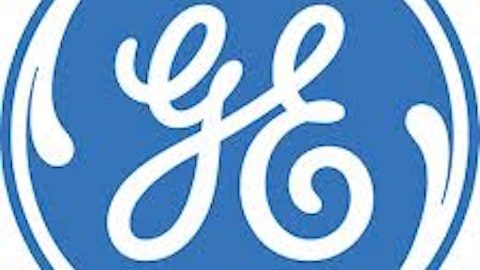Honeywell International Inc. (NYSE:HON) is a conglomerate of aerospace and industrial businesses, and is the world’s largest maker of avionics. They have grown their sales nicely over the past decade, from around $23 billion to almost $38 billion annually, and shareholders have done very well as a result. With the improving economy, will Honeywell continue to benefit from increased spending, or should its investors take their profits?
Company profile

Honeywell runs its businesses through four segments, the most well-known being the Aerospace segment, which contributes 36% of Honeywell International Inc. (NYSE:HON)’s operating profit. The segment makes products for both commercial and military aircraft, specifically cockpit controls, safety systems, auxiliary power units, sensors, lighting equipment, as well as wheels and brakes.
The largest competitor for these products is Rockwell Collins, Inc. (NYSE:COL) which has an almost identical product mix to Honeywell’s aerospace segment. While I love Rockwell Collins as a company, I feel that the recent rally in its shares (there was a sharp 10% spike recently) is a bit overblown, and that it is currently a bit overvalued. Additionally, for long term investors, Honeywell gives the added security of not being entirely dependent on one sector.
The aerospace segment also makes small jet engines for business jets and smaller commercial aircraft. The other major players in the small jet engine segment competing with Honeywell International Inc. (NYSE:HON) are Pratt and Whitney, which is a division of United Technologies Corporation (NYSE:UTX), as well as General Electric Company (NYSE:GE)’s jet engine segment.
United Technologies, in addition to Pratt and Whitney, their jet engine business, produces climate control products under the well-known Carrier brand, fire safety and security products, elevators and escalators through their Otis subsidiary, and they are the world’s largest manufacturer of military and commercial helicopters through their Sikorsky brand.
General Electric Company (NYSE:GE) is a highly diversified conglomerate and one of my favorite companies itself. The only thing I really don’t like about GE is their exposure to financial services. GE makes energy infrastructure products, healthcare equipment, locomotives, and their well-known line of appliances, in addition to the aforementioned jet engine business.
Honeywell’s largest segment (by revenue) is the Automation and Control Solutions segment (37% of profit), and it produces such products as environmental controls, sensing controls, scanning products, automation products, and many others.
The Specialty Materials segment (18% of profit) makes chemicals and fibers primarily for the petrochemical, food, pharmaceutical, and packaging industries. Finally, the Transportation segment (9% of profit) makes turbochargers (for engines), radiators, brakes, and other automotive products, and up until 2011 made a variety of car care products for consumers.
Why Honeywell?
So, why invest in Honeywell instead of the other three companies listed?
Honeywell’s products stand the most to gain out of any company mentioned here, due to the trend towards energy efficiency. Virtually all of Honeywell’s businesses play a role in increasing efficiency, with a particular edge because of their turbocharger and environmental controls businesses. For those who aren’t “car guys,” turbochargers are a way to use an engine’s waste product (exhaust) and use it to squeeze extra power out of an engine, with no additional fuel (in theory).
The three competitors mentioned above all have some products that will benefit from this trend; none have quite the range of (potentially) efficiency-increasing products as Honeywell does.
Growth and valuation
For this reason, and a few others, analysts are generally positive about Honeywell’s potential for growth. The company is expected to earn $4.94 for 2013, and this is projected to increase to $5.49 and $5.95 in 2014 and 2015, respectively, for an average forward growth rate of just under 10%. That’s not too bad for a company trading at 14.9 times forward earnings.
Honeywell has a very strong balance sheet, which features, among other things, over $5 billion in cash. They are also a good dividend payer, currently yielding 2.23% annually, and they have raised the payout every year over the past decade except for one.
Conclusion
Of the companies listed here, all except Rockwell Collins are well-diversified and give investors good exposure to many industries. General Electric Company (NYSE:GE) is a great addition to any portfolio, provided you don’t mind a lot of financial exposure. United Technologies has a lot to like as well, however I believe that the trend toward energy efficiency is going to be long-lasting and not just a passing fad as some believe. As a result, I like Honeywell since I believe they have the most to gain from this kind of long-term trend.
The article This Aerospace Giant Could Benefit From the “Green” Trend originally appeared on Fool.com and is written by Matthew Frankel.
Copyright © 1995 – 2013 The Motley Fool, LLC. All rights reserved. The Motley Fool has a disclosure policy.


